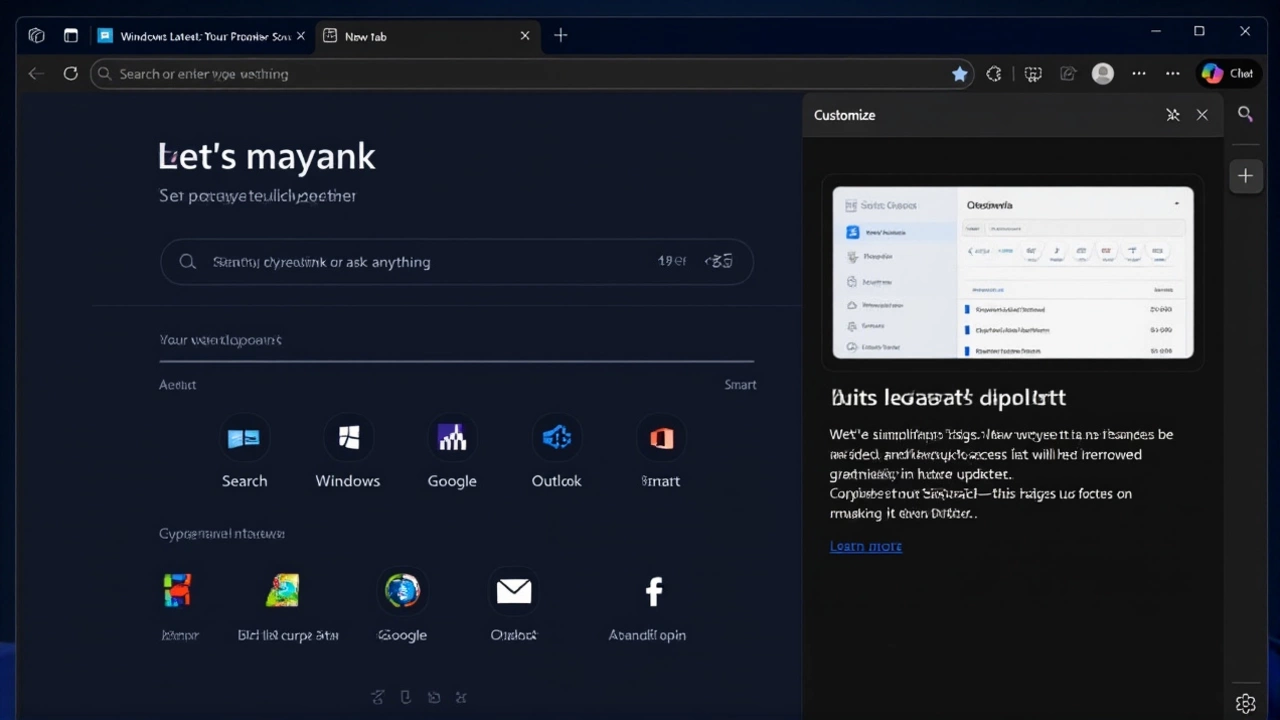Microsoft Corporation is quietly killing one of Microsoft Edge’s most customizable features — the Sidebar app list — to clear space for its AI-powered Copilot. The change, first spotted in Edge Canary build 133.0.2938.0 on November 12, 2025, comes with a blunt in-app message: "We're simplifying Edge. New apps can no longer be added, and the quick access list will be removed gradually in future updates. Copilot is not affected." For users who relied on the Sidebar to pin their favorite web apps — from Notion to Trello to custom dashboards — this isn’t just a UI tweak. It’s a signal: Microsoft’s vision for the browser no longer includes user-driven customization. It’s all about Copilot now.
What the Sidebar Really Did
The Sidebar, introduced in Microsoft Edge 111 back in 2023, wasn’t just a convenience. It was a workspace. Users could drag any website into the left or right edge of the browser and keep it open as a persistent panel, toggling between tabs and apps without losing context. Administrators could control it via Group Policy — enabling or blocking specific URLs, or even disabling it entirely with the EdgeSidebarEnabled registry key. Microsoft Learn’s November 2025 documentation confirmed it was officially called the "Hubs Sidebar," and its removal would also disable the Discover app in the toolbar. For power users, it was a productivity lifeline. For enterprise IT teams, it was a manageable feature — until now.
Copilot’s Quiet Takeover
The space once reserved for the Sidebar icon is now occupied by Copilot. On the stable version of Edge, users could toggle between the two — hide Copilot to show the Sidebar, or vice versa. But in Canary, that choice is vanishing. Windows Central reported on November 12, 2025, that the same real estate now opens Copilot by default. And it’s not just in the browser. In Windows 11 24H2 (build 26100), released in October 2025, Copilot is no longer a standalone app. It’s a web shell wrapped in a Start menu shortcut, launched via ms-edge:// URIs. There’s no Copilot.exe anymore. To disable it, admins must disable four separate policies: "Show or hide side panel," "Allow Microsoft Edge Sidebar," "Allow Copilot in Microsoft Edge," and "Configure Copilot in Microsoft Edge."
Why This Matters Beyond the Browser
This isn’t just about a browser sidebar. It’s about Microsoft’s broader strategy. With 221,000 employees and a $2.3 trillion market cap, the company is betting everything on AI. Copilot isn’t just a feature — it’s the new interface for Windows, Office, and now Edge. The decision to remove user-controlled apps in favor of a single AI assistant reflects a top-down philosophy: Microsoft knows what’s best for you better than you do. And if that means sacrificing flexibility for consistency? Fine. The backlash is predictable. Eleven Forum users complained on November 14, 2025, that they couldn’t remove the Copilot search box from Edge’s front page. Wilders Security forums erupted with users asking: "Why can’t I turn this off?" The answer, increasingly, is: you can’t.
What’s Next for Edge Users
The full removal of the Sidebar app list won’t hit the stable channel until early 2026, but the writing is on the wall. Microsoft is testing this in Canary — the most volatile, experimental branch — to gauge reactions. If users complain loudly enough, they might delay the rollout. But history suggests otherwise. Microsoft removed the Favorites Bar toggle in Edge 2021. It buried the Reading View button. Each time, users grumbled — then adapted. The pattern is clear: Microsoft prioritizes its AI agenda over user preference. For enterprise users, the Group Policy controls still exist — for now. But Microsoft’s own documentation hints that future updates will simplify these settings further. Expect fewer toggles, more automation.
The Bigger Picture: AI or Autonomy?
This move echoes Apple’s removal of the menu bar clock in macOS Sonoma, or Google’s decision to phase out Chrome extensions that modified UI elements. It’s not about bugs or performance — it’s about control. Microsoft wants users to interact with their devices through Copilot, not through their own curated workflows. The irony? The Sidebar was designed to help users stay productive without switching apps. Copilot, for all its hype, still struggles with context, accuracy, and workflow integration. It’s a tool. The Sidebar was a canvas. And now, Microsoft is painting over it.
Frequently Asked Questions
Can I still use the Sidebar app list in the stable version of Microsoft Edge?
Yes, as of November 15, 2025, the Sidebar app list remains fully functional in the stable release of Microsoft Edge. The retirement notice only appears in Edge Canary, Microsoft’s experimental build. The change is expected to reach the stable channel in Q1 2026, but administrators can still disable it via Group Policy before then.
How do I disable Copilot in Microsoft Edge if I don’t want it?
To fully disable Copilot in Edge, enterprise admins must set four Group Policy settings to "Disabled": "Show or hide side panel," "Allow Microsoft Edge Sidebar," "Allow Copilot in Microsoft Edge," and "Configure Copilot in Microsoft Edge." The registry equivalent is setting "EdgeSidebarEnabled" to dword:00000000 under HKEY_LOCAL_MACHINE\SOFTWARE\Policies\Microsoft\Edge. Regular users can hide the icon but can’t remove the underlying integration.
Will removing the Sidebar affect my saved bookmarks or tabs?
No, your bookmarks, history, and open tabs are unaffected. The Sidebar app list only removes the ability to pin external web apps as persistent panels. Your personal data, including passwords and reading lists, remains intact. However, any custom dashboards or productivity tools you accessed through the Sidebar will need to be reopened as regular tabs or replaced with alternatives.
Why is Microsoft removing user customization for AI features?
Microsoft is betting that AI will become the primary interface for productivity — not manual navigation. By removing customizable elements like the Sidebar, they reduce complexity and steer users toward Copilot as the default solution. It’s a strategic shift from "you control your tools" to "we control your workflow." This mirrors Apple’s and Google’s similar moves toward streamlined, AI-centric interfaces.
Are there any third-party alternatives to the Sidebar app list?
Yes. Tools like Sidebery (for Firefox) and Tab Manager Plus (Chrome extension) offer similar multi-panel functionality. Some users have also turned to dedicated desktop widgets or third-party launchers like Launchy or AutoHotkey scripts to replicate the Sidebar experience. But none integrate as seamlessly as Microsoft’s native solution — and none are guaranteed to survive future Windows updates.
Does this change affect Windows 10 users?
No. This change only applies to Microsoft Edge on Windows 11, specifically builds 24H2 and later. Windows 10 users running Edge version 111 or higher still retain full Sidebar functionality, as Microsoft has not extended this policy change to older operating systems. However, Windows 10 support ends in October 2025, so the window to use it is closing.






